Physical Address
304 North Cardinal St.
Dorchester Center, MA 02124
The chiasm is so named because it is shaped like the Greek letter chi. Over 2 million nerve fibers pass through it: most are visual, but some non-visual fibers project from the optic chiasm to hypothalamic nuclei, forming the retinohypothalamic tract subserving circadian rhythms. The ratio of crossed to uncrossed fibers in the human chiasm is about 53 : 47.
The chiasm provides the major route for the juxtaposition of corresponding parts of the visual field in each eye. It is important for binocular vision. To establish fusion, it is necessary to have overlapping visual fields, congruence of corresponding retinal elements, and for the extraocular muscles to maintain alignment of the visual axes. In lateral-eyed animals, optic fibers from each eye decussate entirely to the contralateral hemisphere. The percentage of uncrossed fibers increases as the orbits rotate anteriorly and the frontal field of single binocular vision increases. The reason that our visual system is crossed is controversial ( Fig. 57.1 ).
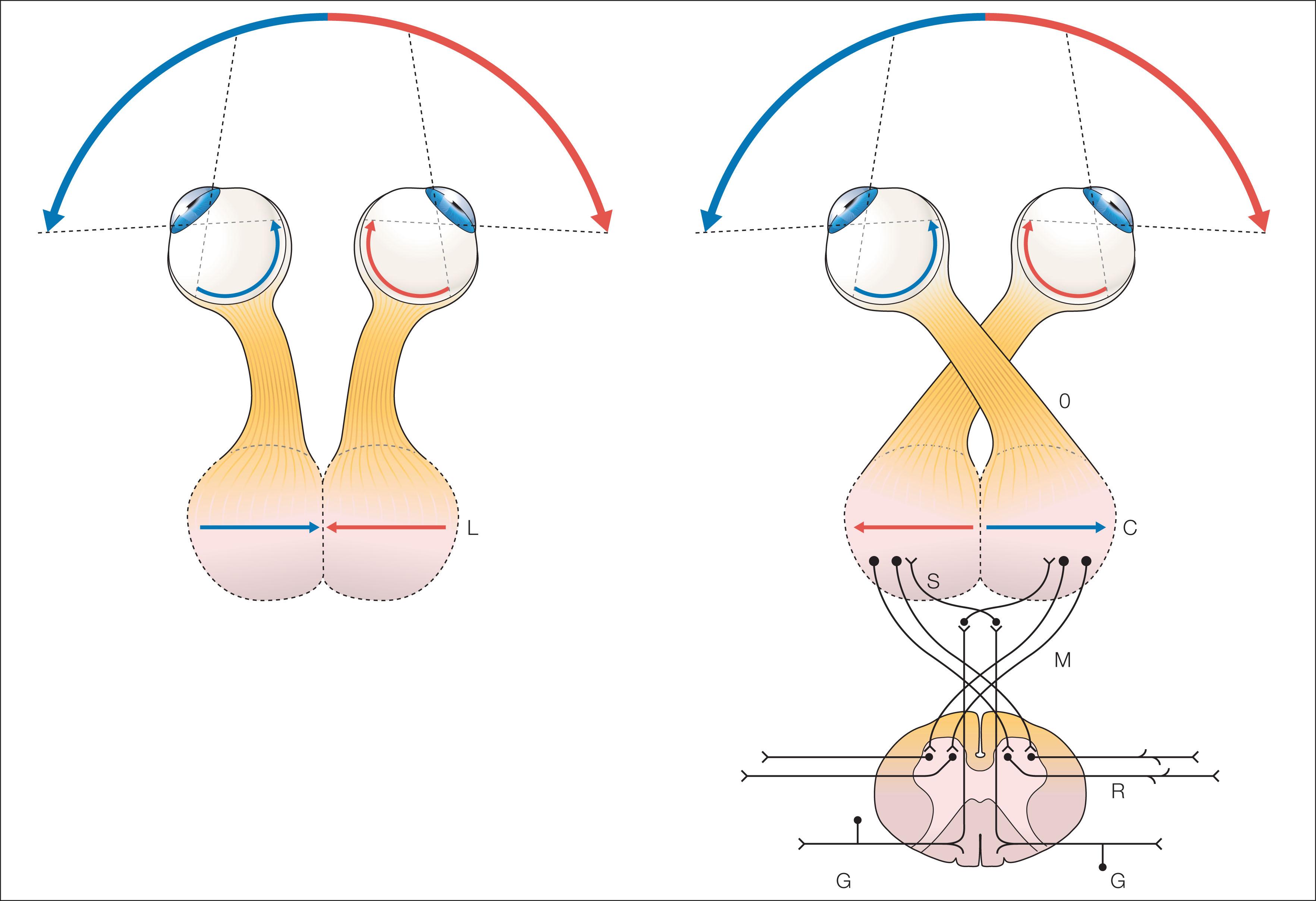
In humans, there is more retina nasal to the fovea than temporally, so the right eye covers more right visual field than left visual field. The primordial nasal retinas are concerned with a phylogenetically older “panoramic” function. The temporal retinas have entered into a phylogenetically younger “binocular” function.
Our foveas are placed where nasal (panoramic) and temporal (binocularity-providing) retinas intersect. This allows vision to subserve its elemental functions, namely:
Exploration (mobility)
Detail (foveas)
Stereopsis (binocularity).
Exploration of the surround is a primordial panoramic function of the nasal retinas, while binocular vision, stereopsis, and convergence concern the temporal retinas.
The optic nerves, chiasm, and optic tracts extend posteriorly and upward 45 degrees from the optic canals in adults and children. The chiasm lies in the suprasellar cistern several millimeters above the diaphragma sellae. The anterior cerebral arteries and the anterior communicating arteries lie anteriorly and above the chiasm and optic nerves. The carotid arteries lie laterally, with the posterior communicating artery passing underneath the optic tracts. The chiasm lies in the floor of the anterior end of the third ventricle. Expansion of the third ventricle may cause chiasmal compression. Posteriorly lie the hypothalamus and the pituitary stalk, the tuber cinereum, and the mamillary bodies. The optic nerves emerge from the optic canals. The length of the intracranial optic nerve varies, so the position of the chiasm in relation to other structures also varies. When the optic nerves are short, the chiasm is “prefixed,” when long it is “postfixed.” Wilbrand's knee is now considered to be an artefact, and most junctional scotomas are shown on MR imaging to have a component of direct chiasmal compression.
The chiasm appears in the first month of life, arising from a thickening of the floor of the forebrain. Retinal ganglion cells (RGCs) grow down the optic stalks and enter the floor of the third ventricle where they decussate to form the optic chiasm. The pattern of axon crossing occurs in two phases. The first retinal axons meet in the midline at the ventral diencephalon, forming an H-shaped chiasm (rather than the X-shaped chiasm that has been traditionally described), allowing continuing axons to grow into the ipsilateral or contralateral optic tract.
In the mouse, neurons at the site of the future chiasm are required for its formation by retinal ganglion cell axons. A growth-associated protein essential for chiasm formation has been identified. There is substantial overproduction of neurons which later die back by apoptosis. The chiasm reaches its definitive form by the fourth month of gestation. A morphological specialization of the axon called a growth cone allows each axon to sense and respond to signals in the embryonic brain environment. Neuronal and glial cells provide guidance information to ingrowing RGC axons within the developing chiasm. Histologic evidence suggests that uncrossed axons are confined within the lateral portion of the optic nerve and do not approach the chiasmal midline. Neurons and radial glial cells in the ventral diencephalon also serve a role in RGC axon guidance during chiasm formation. Growth-associated proteins in retinal growth cones enable RGC axons to progress and perform path-finding tasks.
Numerous guidance molecules and transcription factors that pattern the developing chiasm have been identified ( Fig. 57.2 ).
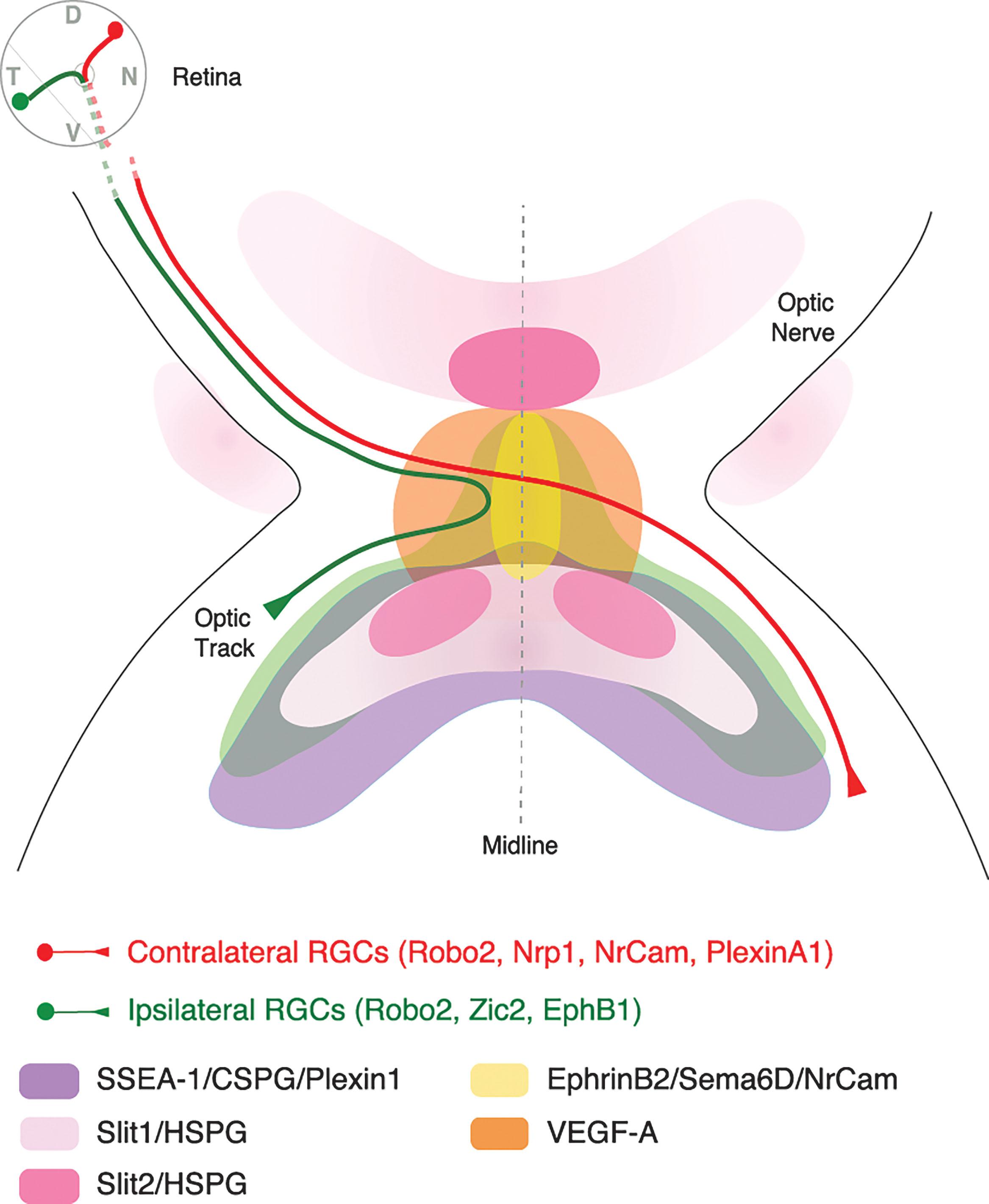
Inhibitory molecules provided by Slits help to channel retinal axons ipsilaterally and contralaterally. Eph-B1 and Ephrin-B2 are critical for growth of ipsilateral axons. Foxd1 expressed in the developing temporal retina and its downstream effectors (tyrosine kinase membrane proteins) are involved in patterning of the optic chiasm in chicks and mammals. Foxd1 imprints axons ipsilaterally. Foxd1 is expressed in progenitors of Zic2-positive retina ganglion cells and is the determinant of temporal retinal identity. Nr-CAM is a cell adhesion molecule that promotes midline crossing of retinal ganglion cells, while Shh helps to direct growth of ipsilateral axons. Eph-B1 and Ephrin-B2 are critical for growth of ipsilateral axons. Neuropilin molecules are transmembrane proteins that serve as receptors for axonal guidance to regulate axon divergence at the chiasm in mammals. Neuropilin 1 (NRP1) is expressed at the chiasm midline, and acts on contralateral retinal ganglion cells to provide growth-promoting and chemo-attractive signals for commissural axon crossing at the chiasm. Ventral anterior homeobox 1 (Vax1) has also been found to possess retinal ganglion cell growth factor activity that is necessary for chiasmal development in the mammalian binocular visual system.
Developmental defects and suprasellar tumors are common in children ( Table 57.1 ). Most chiasmal syndromes result from neoplastic disorders, developmental derangements, radiation injury, inflammation, infection, demyelination, infarction, transection, or hypoplasia. Dominant optic atrophy may present with a bitemporal hemianopia simulating a chiasmopathy.
Loss of stereopsis
Postfixational blindness
Loss of motor fusion
Hemifield slide
Bitemporal hemianopia
Bagolini striated lenses “mountain” pattern
Worth 4-dot (selective loss of temporal green dot as viewed through green lens)
Large pupils/sluggish pupillary responses/light–near dissociation
Small optic discs (for congenital tumors)
Bilateral band atrophy (for acquired lesions)
“Spasmus nutans” in infancy
See-saw nystagmus
Monocular temporonasal optokinetic asymmetry
In young children, compressive chiasmal disease often presents late because the child compensates and is not suspected of having poor vision until there is substantial bilateral visual loss.
The hallmark of chiasmal disease is a bitemporal hemianopia. Compressive bitemporal hemianopias are rarely complete (although this distinction can be difficult to make in children), and there is often an associated visual acuity deficit due to contiguous optic nerve compression. Inferior lesions have to grow large before signs of chiasmal compression appear. They compress the lower nasal fibers first and tend to give an upper bitemporal field defect. Lesions from above tend to cause a greater defect inferiorly. By the time a compressive lesion has caused visual field defects, there is usually thinning of the chiasm and the pattern of the field defect is not always clear-cut in children.
Traumatic injuries that split the mid-chiasm do not diminish visual acuity. However, suprasellar tumors often diminish acuity and color vision by compressing both crossed and uncrossed fibers within the chiasm, or by compressing the adjacent optic nerves. Frequently, one eye has a severe acuity defect and the other is relatively spared, except for a field defect. In chronic lesions, there may be preservation of a high level of acuity despite funduscopic or evidence of a profound loss of neurons.
Complete monocular temporal hemianopias are generally functional, however, compression of the nasal optic nerve adjacent to the chiasm (where crossing axons have segregated) can produce a partial monocular temporal hemianopia.
When there is chiasmal compression, the pupils may be large and sluggishly reactive to light, resulting in light–near dissociation. Stereoacuity tests and Bagolini striated lenses are useful tests in patients with suspected chiasmal compression. Decreased stereoacuity is common with chiasmal lesions, even when no visual field abnormalities are detectable. However, stereopsis can be elicited with complete chiasmal transection by haploscopic stimulation of the intact temporal retinas. This shows the sensory capacity for stereopsis is retained in chiasmal transection, but the absence of motor fusion precludes stereopsis. Bagolini striated lens testing reveals a binocular “mountain” pattern in chiasmal lesions. Children with early-onset chiasmal disease may present with nystagmus. The classic form is a spasmus nutans-like nystagmus with variable head titubation, but isolated see-saw nystagmus can also occur (see Chapter 90 ). Loss of chiasmal crossing fibers also causes loss of monocular nasalward horizontal optokinetic responses in each eye. In young children in whom reliable visual fields are not easily obtained, we have found this monocular temporonasal optokinetic asymmetry to be a useful clinical clue to the presence of chiasmal disease.
Optic atrophy frequently accompanies chiasmal disease. There may be a generalized loss of neurons, or a pattern of band atrophy due to selective loss of fibers subserving the temporal fields and the preservation of fibers subserving the intact nasal field ( Fig. 57.3 ). In developmental chiasmal defects and tumors, there are often optic disc anomalies ( Figs. 57.4 and 57.5 ). Congenital suprasellar tumors can produce horizontal “bow-tie” cupping with selective loss of the nasal and temporal nerve fiber layer. Papilledema in these optic discs occurs predominantly in the superior and inferior poles (see Fig. 57.3 ).
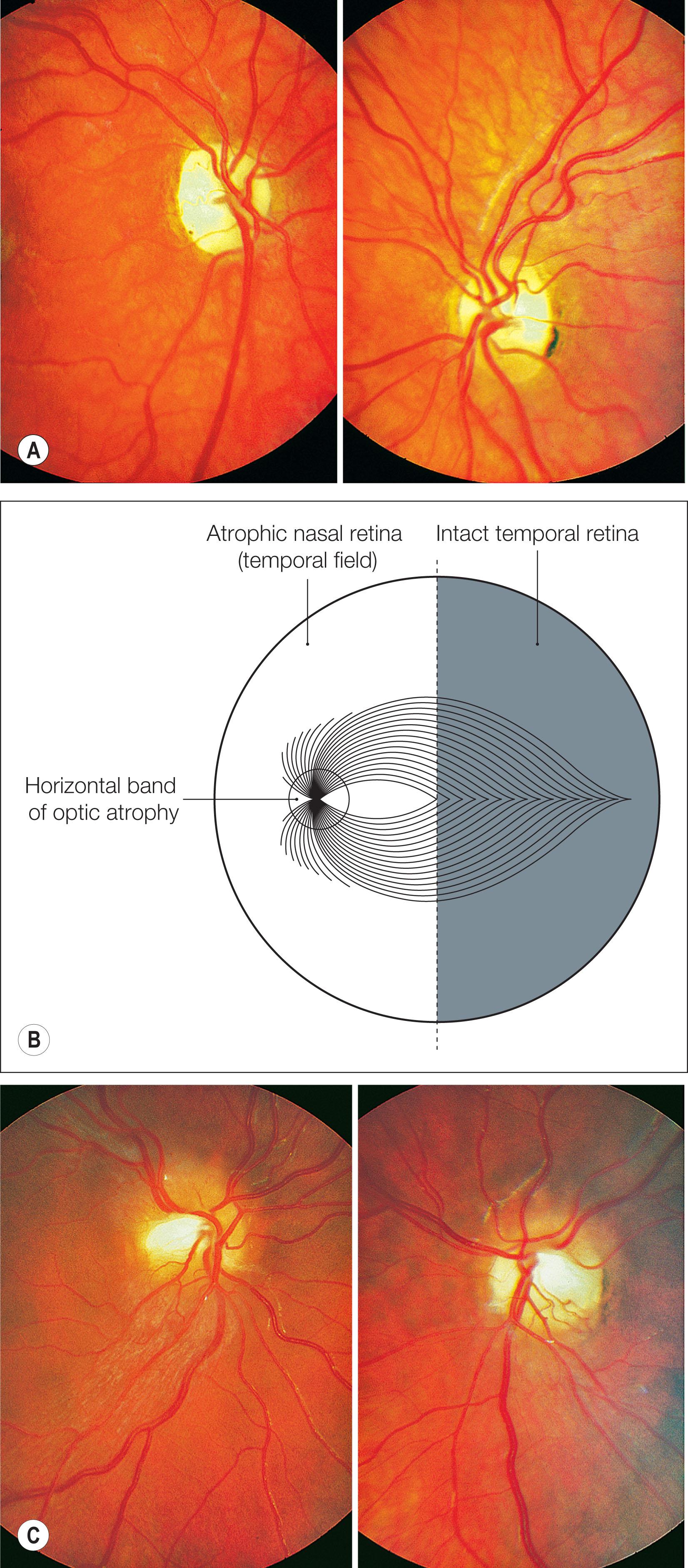
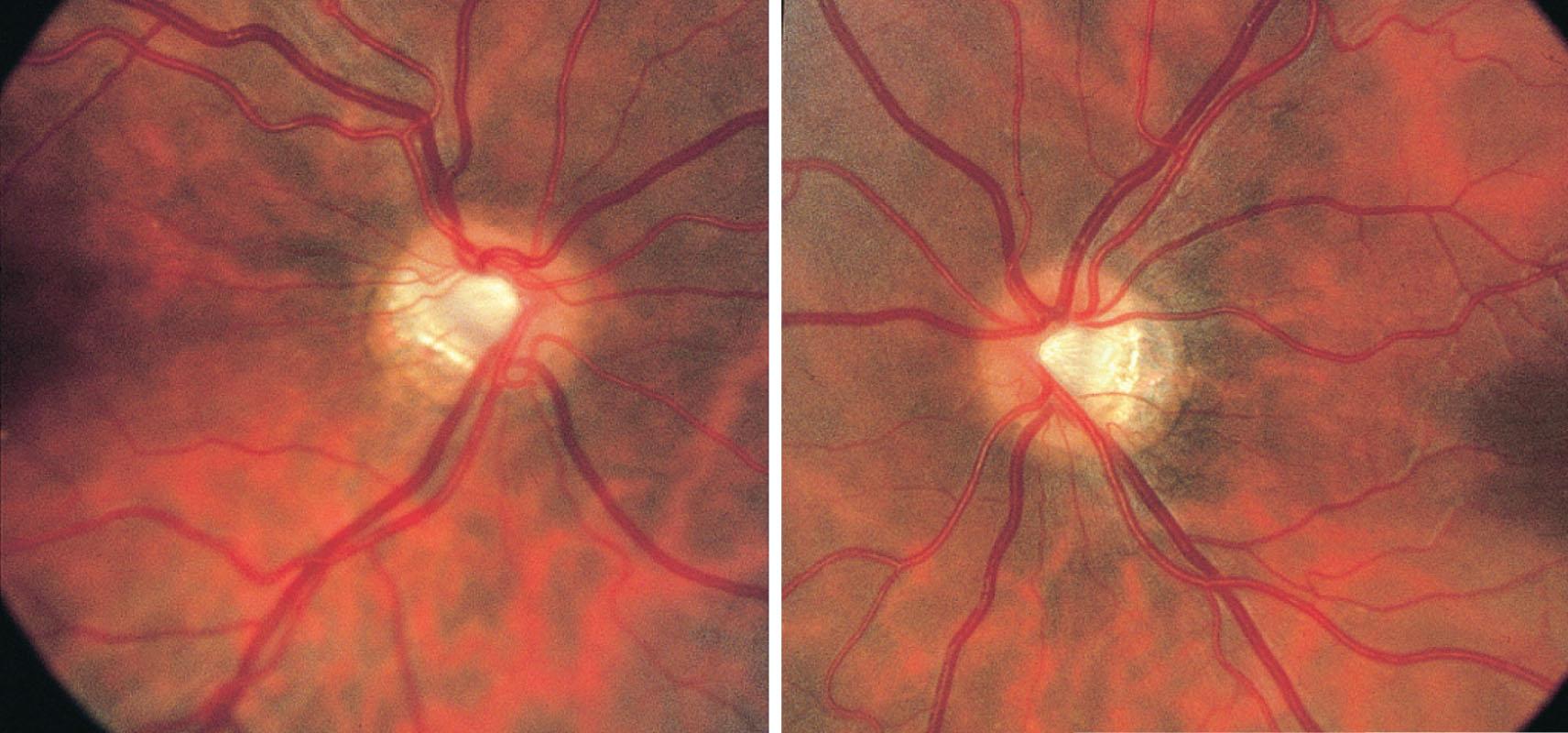
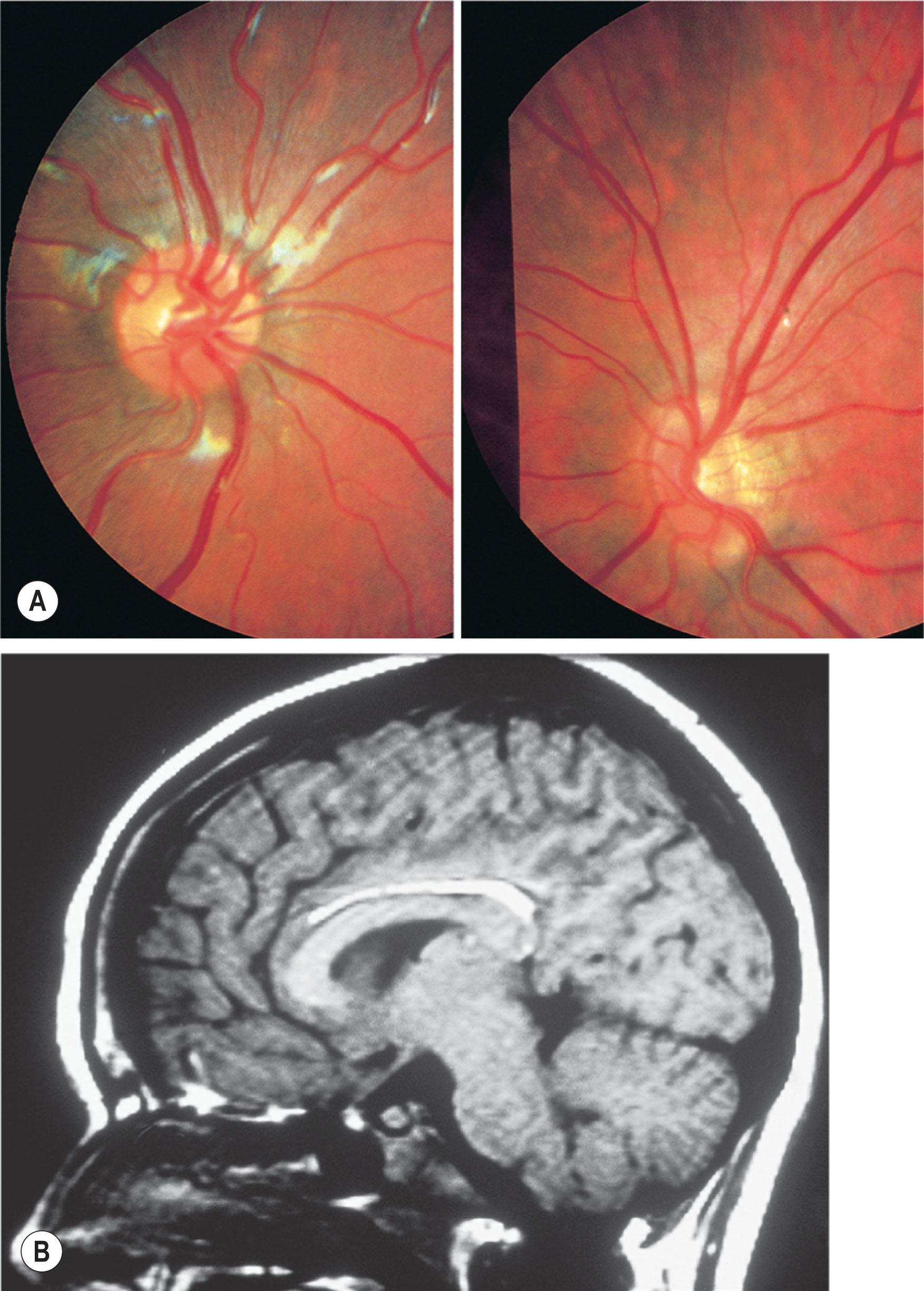
Because of the proximity of the hypothalamus and pituitary gland, endocrine and growth defects may occur. Infants with hypothalamus-involving tumors may develop Russell diencephalic syndrome: emaciation with loss of subcutaneous fat ( Fig. 57.6 ), accelerated growth in length relative to weight ( Fig. 57.7 ), and personality changes with euphoria and hyperactivity. One must examine and measure the body habitus and inquire about weight gain.
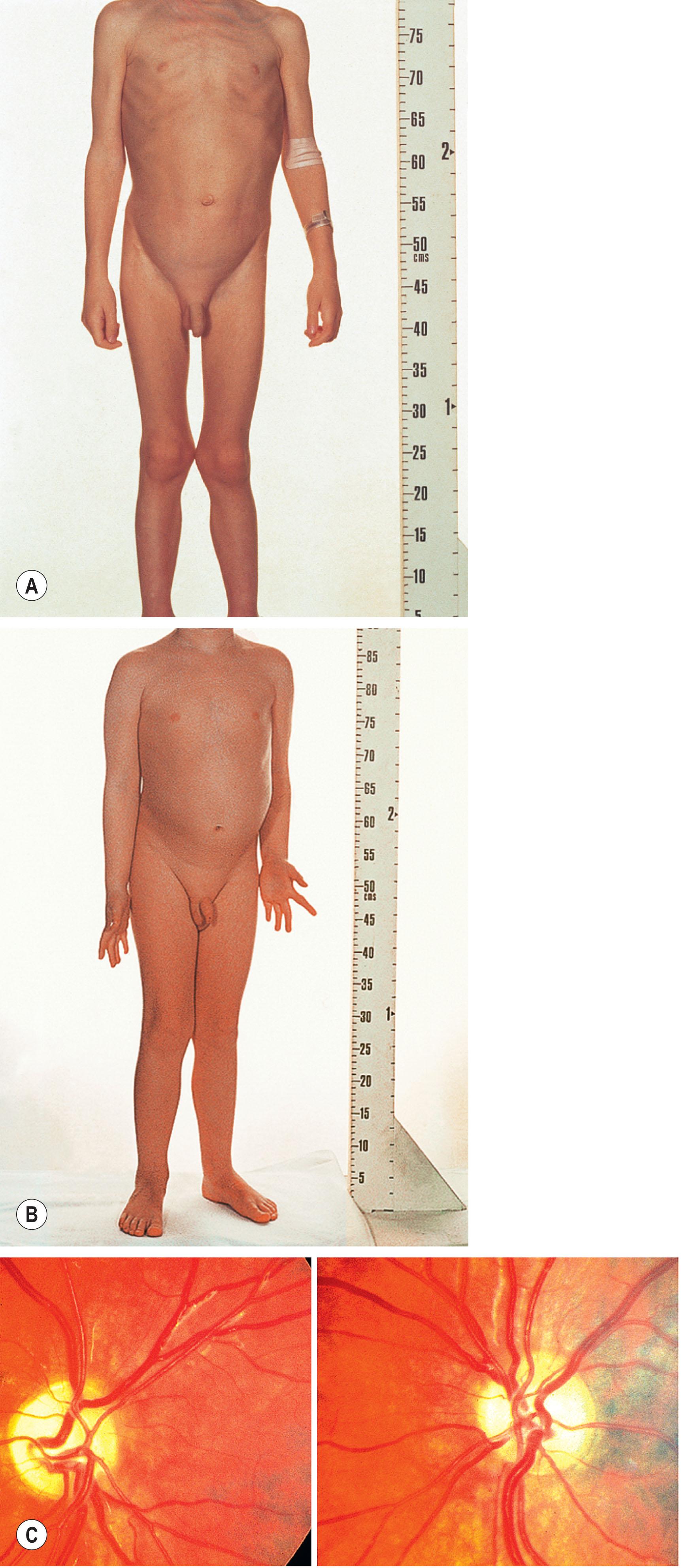
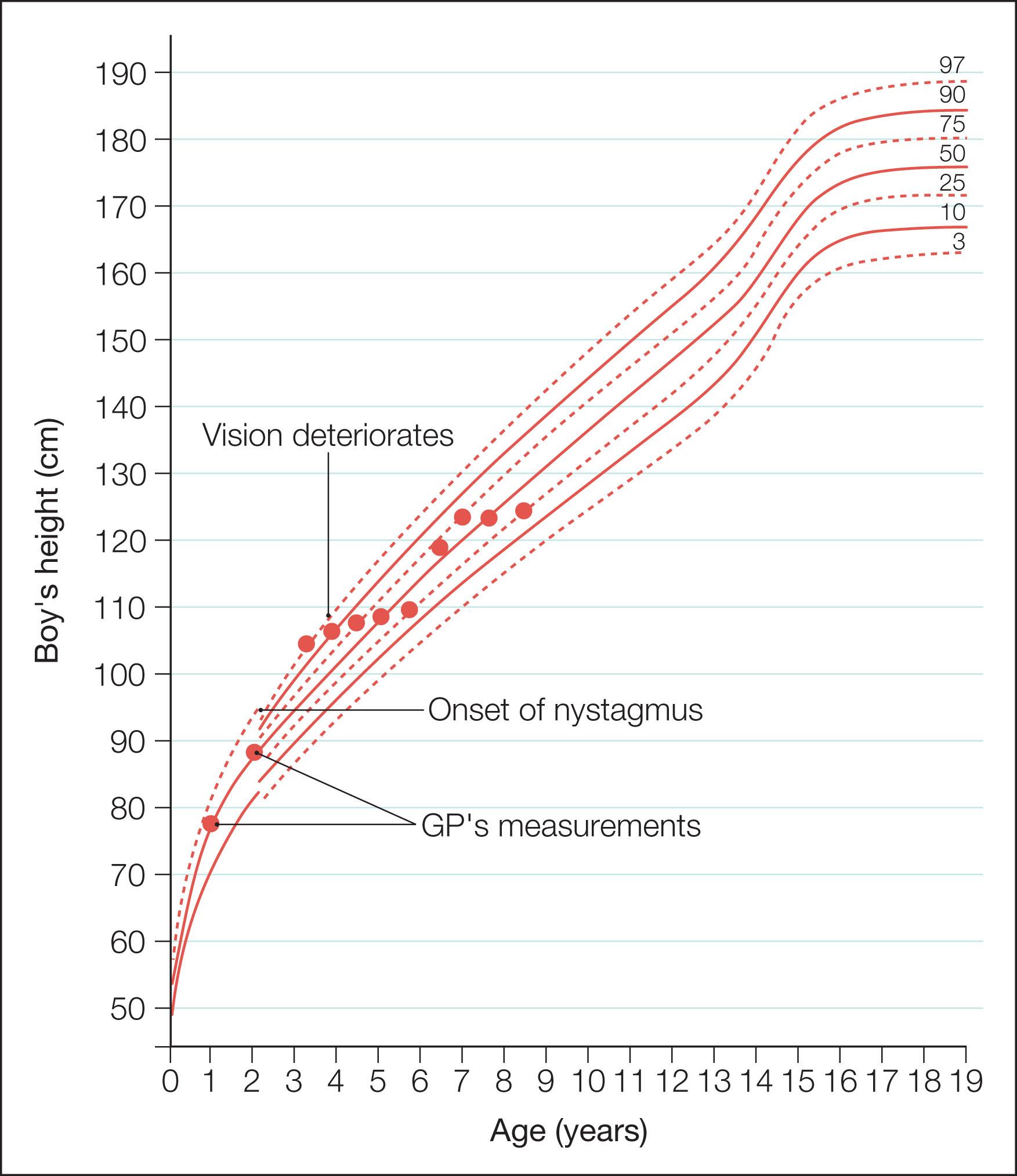
Symptomatically, patients with severe bitemporal hemianopia may report postfixational blindness (e.g. noticing that the road disappears when looking at the front windshield glass from the inside of the car). More commonly, symptoms of the hemifield slide phenomenon can be elicited ( Fig. 57.8 ). Since only the nasal portion of each visual field is functioning fully, corresponding retinal points between the two eyes no longer exist. Sensory fusion becomes impossible, and motor fusion cannot maintain alignment. A previous heterophoria becomes a manifest deviation. Esodeviations lead to letters or words appearing deleted. Exodeviations produce letters or words appearing duplicated. A vertical hemifield slide causes the child to lose track of which line of text they are reading. These children do not complain of diplopia but rather a duplication of the middle of words or objects. The hemifield slide phenomenon does not require a complete bitemporal hemianopia, and can occur as the initial symptom. Signs and symptoms of chiasmal disease are summarized in Box 57.1 . Rarely, chiasmal tumors can produce photophobia as their presenting symptom.
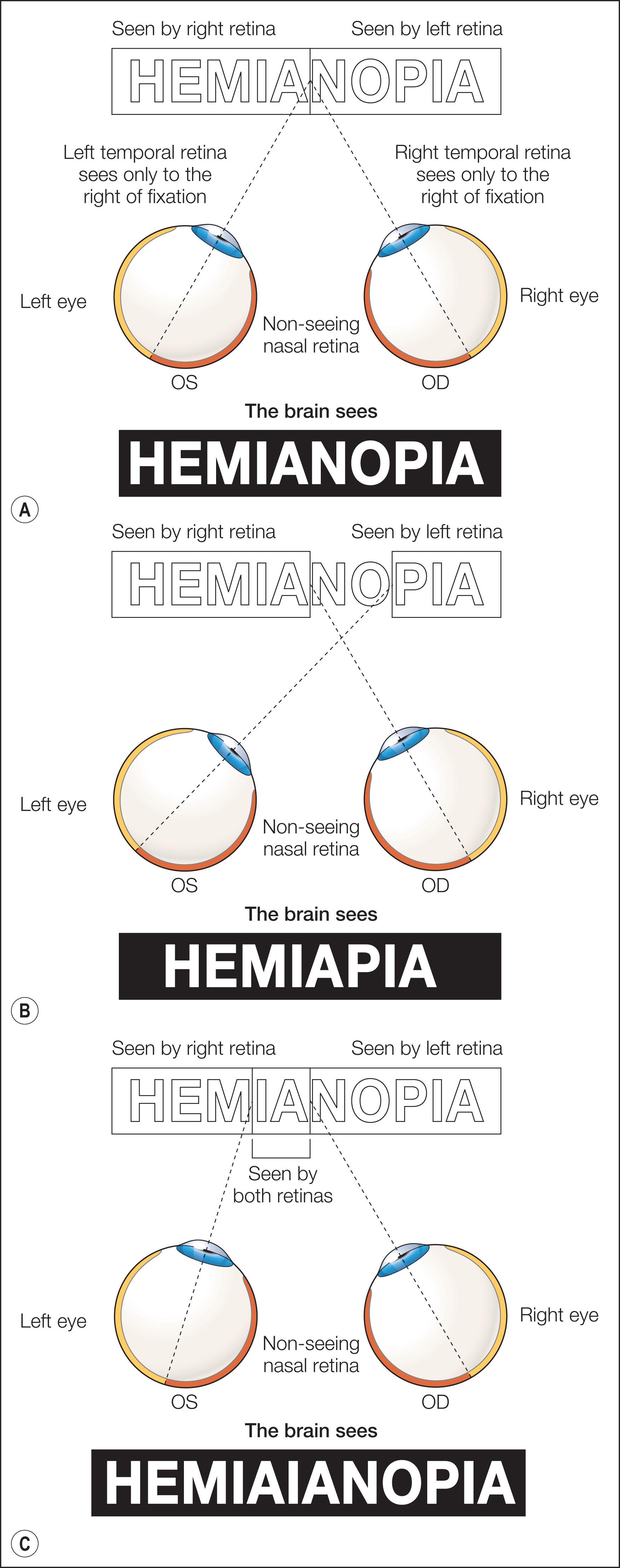
| Category | Disease/disorder |
|---|---|
| Developmental defects |
|
| Tumors |
|
| Trauma |
|
| Infiltration |
|
| Chiasmal neuritis |
|
| Optochiasmatic arachnoiditis |
|
| Vascular anomalies |
|
| Radiation | Acute visual loss months to years after radiation |
| Empty sella |
|
Further investigations consist of endocrine studies, neurophysiological evaluation (see Chapter 7 ), neuroimaging, and optical coherence tomography (OCT). OCT of the macular ganglion cell layer is highly sensitive to binasal retinal nerve fiber layer thinning resulting from congenital or acquired chiasmopathies. In acquired chiasmal compression, OCT changes of the macular ganglion cell layer usually precede early visual field defects and persist following decompression. Neurophysiological studies may detect a crossover defect (particularly in a preverbal child) and quantitatively and qualitatively assess the visual defect. Magnetic resonance imaging (MRI) provides neuroanatomical detail of the chiasm and surrounding structures. Computed tomography (CT) scanning may provide important information about bony changes involving the parasellar area.
Developmental derangements of the optic chiasm include:
albinism
achiasmia
aplasia
anophthalmia.
Become a Clinical Tree membership for Full access and enjoy Unlimited articles
If you are a member. Log in here